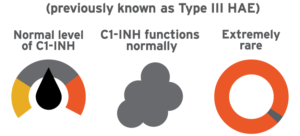Hereditary angioedema (HAE) is characterized by unpredictable episodic swelling without pruritus. Attacks can be severe, sometimes life-threatening, causing significant morbidity and disability.1,2
Patients with HAE are subject to localized attacks of subcutaneous and/or submucosal swelling. Typical therapies for angioedema are ineffective in patients with HAE; thus, a correct diagnosis is crucial.
Depending on the severity of the disease, some patients will have frequent attacks, while others may have a few throughout the year.2 Many people have their first attack in childhood; attacks typically worsen after puberty and persist through adulthood.2
Physical exertion, stress and trauma are among the most commonly reported triggers of an attack.3


